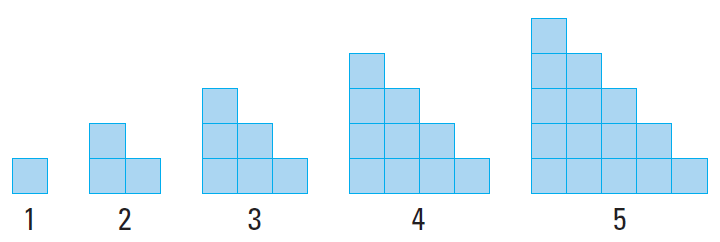INDUCTIVE AND DEDUCTIVE REASONING WORKSHEET
Problem 1 :
Sketch the next figure in the pattern.

Problem 2 :
Describe a pattern in the sequence of numbers. Predict the next number.
1, 4, 16, 64, ............
Problem 3 :
Let p be "the value of x is -5" and let q be "the absolute value of x is 5".
(i) Write p -> q in words.
(ii) Write q -> p in words.
(iii) Decide whether the biconditional statement p <-> q is true.
Problem 4 :
State whether the argument is valid.
Michael knows that if he misses the practice the day before a game, then he will not be a starting player in the game. Michael misses practice on Tuesday so he concludes that he will not be able to start in the game on Wednesday.
Problem 5 :
Write some conditional statements that can be made from the following true statements using the Law of Syllogism.
1. If a bird is the fastest bird on land, then it is the largest of all birds.
2. If a bird is the largest of all birds, then it is an ostrich.
3. If a bird is a bee hummingbird, then it is the smallest of all birds.
4. If a bird is the largest of all birds, then it is flightless.
5. If a bird is the smallest bird, then it has a nest the size of a walnut half-shell.

1. Answer :

Each figure in the pattern looks like the previous figure with another row of squares added to the bottom. Each figure looks like a stairway.
So, the sixth figure in the pattern must have six squares in the bottom row.

2. Answer :
Each number is four times the previous number.
So, the next number is 256.
3. Answer :
(i) If the value of x is -5, then the absolute value of x is 5.
(ii) If the absolute value of x is 5, then the value of x is -5.
(iii) The conditional statement in part (a) is true, but its converse in part (b) is false. So, the biconditional statement p <-> q is false.
4. Answer :
This logical argument is a valid use of the Law of Detachment. It is given that both a statement (p -> q) and its hypothesis (p) are true. So it is valid for Michael to conclude that the conclusion is true.
5. Answer :
Here are the conditional statements that use the Law of Syllogism.
a. If a bird is the fastest bird on land, then it is an ostrich. (Use 1 and 2.)
b. If a bird is a bee hummingbird, then it has a nest the size of a walnut half-shell. (Use 3 and 5.)
c. If a bird is the fastest bird on land, then it is flightless. (Use 1 and 4.)
Kindly mail your feedback to v4formath@gmail.com
We always appreciate your feedback.
©All rights reserved. onlinemath4all.com
Recent Articles
-
Logarithmic Derivative Problems and Solutions
Apr 16, 25 09:25 PM
Logarithmic Derivative Problems and Solutions -
Digital SAT Math Problems and Solutions (Part - 145)
Apr 16, 25 12:35 PM
Digital SAT Math Problems and Solutions (Part - 145) -
Digital SAT Math Problems and Solutions (Part - 144)
Apr 14, 25 07:27 PM
Digital SAT Math Problems and Solutions (Part - 144)

